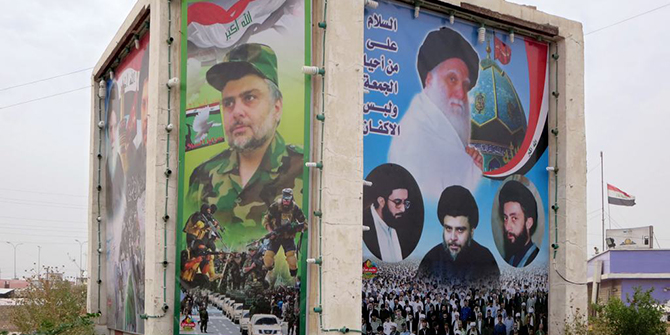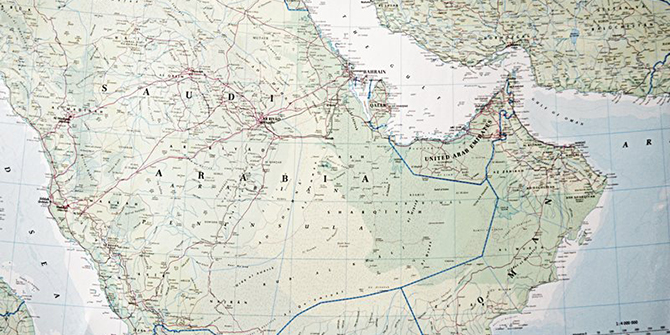by Morten Valbjørn
This memo was presented at a workshop organised by the LSE Middle East Centre on 29 June 2018 looking at the comparative politics of sub-state identity in the Middle East.

The study of the current (re)emergence and evolution of sectarianism in the Middle East has given rise to much debate in academia, but maybe for the wrong reasons. While much energy has been spent bashing primordialist and instrumentalist approaches, in their ‘pure’ versions they appear far less prominent in the academic part of the debate than often claimed. So, instead of ‘beating dead horses’, it appears to be time to turn attention to how an agreement about the need to get beyond the primordialist Scylla and Instrumentalist Charybdis does not have to translate into much consensus about the specific coordinates for the much-aspired third-way-in-between course. At least three different overall ‘beyond strategies’ for a ‘third way’ can be identified, which may lead the future study of sectarianism in different directions and this should be the real debate!
In the new millennium and in particular since the Arab uprisings, Shia/Sunni sectarianism has become a catchphrase in politics, media and academia. Some even describe Western and Arab commentators, policy makers, analysts and academics as fixated on sectarianism.
This renewed attention to sectarianism has not only produced a huge body of academic, policy and more popular literature on sectarianism, it has also given rise to an increasingly sophisticated debate on how to conceptualise, map and explain the causes and consequences of the (re)emergence and evolution of sectarian politics in the Middle East.
For a debate, which traditionally has been empirically rich, but quite descriptive and often based on single case studies (usually of Lebanon) with theoretical assumptions only made implicitly, this growing acknowledgment of the need for some kind of theoretical/analytical upgrade is very welcome. However, in order to succeed in this endeavour, it seems for two reasons useful to first take a critical look at how the debate on sectarianism is debated among the proponents of this upgrade.
The first reason relates to how the existing study of sectarianism usually is framed and how accurate it actually is. Even a cursory examination of the more theoretically informed recent literature will show a common feature in terms of what one could call the ‘beyond primordialism and instrumentalism framing’. Thus, a very popular opening paragraph is a statement about how the existing debate is polarised between two camps, both of which are so flawed that it is imperative to move beyond them.
On the one hand, you have the primordialists according to whom sectarian identities are given, ancient and unchangeable. The current sectarian tensions are nothing but the most recent expressions of a millennium old religious conflict to be traced back to the early days of Islam. On the other hand, you have the instrumentalists, who regard sectarian identities as modern and malleable and basically nothing but an epiphenomenon driven by others factors or interests. Current sectarian conflicts are for this reason perceived as being about politics rather than piety, and basically an outcome of manipulation and exploitation by rational political elites using the ‘sectarian card’ instrumentally as part of a competition for political influence and scarce material goods.
While these two camps have diametrically opposite views on the causes and drivers of sectarianism, both are usually presented as fundamentally flawed. The primordialists are charged with being blind to the role of other motives and identities – such as class, nationality, political influence, regime survival concern etc. – and to the countless examples over history of inter-sectarian cooperation and intra-sectarian divisions. In turn, the instrumentalists are charged with being too elitists and with perceiving sectarianism in a way similar to the old Marxian idea of ‘false consciousness’. This leaves them unable to explain why an instrumental use of the ‘sectarian card’ sometimes – but not always – resonates among the public, if nobody really believes in it, and blind to how identities over time can become internalised and enable or constrain actors.
All these points of critique may be relevant, but the problem with this ‘beyond primordialism and instrumentalism framing’ is that it does not provide an accurate picture of the current academic debate on the (re)emergence and evolution of sectarianism in the Middle East. In the broader public/policy debate, it might be possible to identify statements close to the two camps, but in the more theoretically informed academic debate, it becomes much more difficult to identify ‘pure’ versions of primordialism and instrumentalism. Some of the scholars, who are often highlighted as such – Geneive Abdo and Vali Nasr (as primordialists) or Gregory Gause and Frederic Wehrey (as instrumentalists) – do on closer inspection appear to be much closer to some of the ‘beyond strategies’.
So, while primordialism and instrumentalism may not be fully absent in the broader debate on sectarianism today, when it comes to the more theoretically informed academic debate, the debate about the pitfalls of these two approaches looks more like ‘beating a dead horse’. If one acknowledges that most scholars appear to agree that, it is necessary to move beyond ‘pure’ versions of both primordialism and instrumentalism, this also means that the picture of the sectarianism debate as polarised into two camps must be replaced by one, where most participants identify themselves a belonging to some sort of third-way-in-between position, which then seems to be the really crowded place in the sectarianism debate.
This brings us to the second reason why it is useful to take a closer look at how the debate on sectarianism is debated among the proponents of a theoretical upgrade. While much of the more theoretically informed recent literature on sectarianism is full of statements about how ‘this book/article/paper will provide the superior third way that gets beyond the pitfalls of both primordialism and instrumentalism’, on closer inspection it becomes clear that these alternatives are far from identical. In other words, an agreement about the need to get beyond the primordialist Scylla and Instrumentalist Charybdis does not have to translate into much consensus about the specific coordinates for the much-aspired third-way-in-between course. While it at first sight may almost appear, as if everybody has their own bid for a ‘superior third way’, it is possible to group these into three overall kinds of ‘beyond strategies.’
One of these strategies is The New Saviour. The point of departure is that primordialist and instrumentalist approaches are so fundamentally flawed that they have to be completely abandoned and replaced by a superior alternative theoretical approach. In order to do so, it is necessary to redirect attention to the broader identity debate and related fields of study. In recent years, this has resulted in the introduction of a range of new potential ‘saviours’ ranging from broader theoretical currents, including various versions of constructivism and institutionalism, historical sociology, critical race theory, ethno-symbolism and the Copenhagen School of securitisation, to specific theoreticians such as Foucault, Said, Sommer and Bourdieu.
Another ‘beyond strategy’ can be called The Baby and the Bathwater. While acknowledging that ‘pure’ versions of primordialism and instrumentalism might be flawed, this strategy is based on a recognition that these two approaches also carry important insights, for which reason one should revise rather than reject them. As an attempt to ‘save the baby from being thrown out with the bathwater’, this has in recent years given rise to calls for combining primordialism and instrumentalism and to various suggestions about how some of the pitfalls of one or the other approach can be countered by integrating insights from for instance constructivism or institutionalism.
A final strategy is LEGO Eclectic Theorising. Similar to Sil and Katzenstein’s call for ‘analytical eclecticism’ in the social sciences, this third ‘beyond strategy’ argues that in order to build complex explanations of the (re)emergence and evolution of sectarianism in the Middle East, it is necessary to adopt a more eclectic strategy that combines a variety of approaches and theories like LEGO bricks. This strategy can, for instance, be identified in some of the analyses of the recent sectarianisation of the conflicts in Syria, Iraq or Yemen, where insights from among others primordialism, instrumentalism, institutionalism and constructivism have been combined in order to account for different dimensions and stages of this process.
Much of the more theoretically informed current scholarship on sectarianism can be situated within one of these three ‘beyond strategies’, which share an overall ambition of getting beyond both primordialism and instrumentalism in their ‘pure’ versions. However, this consensus does not mean that scholars of sectarianism have reached a new consensus or that they do not any longer have anything to disagree about. A lot of diversity exists not only between but also within these overall ‘beyond strategies’ – for instance, there are a number of different suggestions as for who is supposed to be the ‘new saviour’. Similar to the past decades, the study of sectarianism will therefore likely also produce a lot of debate among scholars of Middle East politics in the coming years. But hopefully, the debate will change from ‘beating dead horses’ and ritual calls for getting beyond primordialism and instrumentalism, to discussions about the strengths and weaknesses of the various specific suggestions for third ways, reflections about how the future study of sectarianism should look like in the future, and whether some of the different ‘beyond strategies’ are more likely to bring us there compared to other.

Morten Valbjørn is Associate Professor at the Department of Political Science, Aarhus University, where he is leading the interdisciplinary research project ‘SWAR: Sectarianism in the wake of the Arab revolts’. In addition to sectarianism, his research interests concern various dimensions of identity politics and the sociology of knowledge concerning the study of Middle East politics.
Other memos in the series:
- ‘Seeking to Explain Sectarian Mobilisation in the Middle East’ by Toby Dodge
- ‘Pierre Bourdieu and Explanations of Sectarian Mobilisation in Iraq and the Wider Middle East’ by Toby Dodge
- ‘Tracing the Rise of Sectarianism in Iraq after 2003’ by Toby Dodge
- ‘Identity and State Formation in Multi-Sectarian MENA Societies: Relations between Nationalism and Sectarianism’ by Raymond Hinnebusch
- ‘Beyond the Spectre of Sectarianism: The Case of Tunisia’ by Teije Hidde Donker
- ‘Ontologies of Sectarian Identity: The Many Layers of Sunni–Shi’a Relations’ by Fanar Haddad






